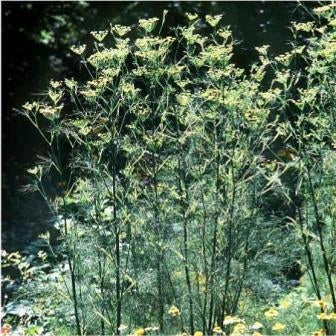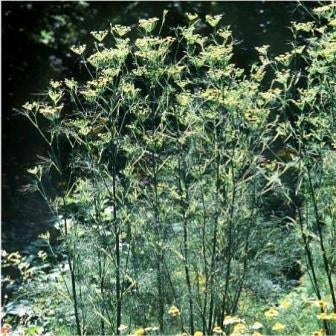AROMATIC FENNEL - kr17
Have a question?

AROMATIC FENNEL - kr17
Dettagli
Scientific name: Foeniculum vulgare dulce Mill.
Family: Apiaceae (Umbelliferae)
Brief history and botanical notes on the plant
Fennel is a Mediterranean herbaceous plant known since ancient times for its aromatic properties, its horticultural cultivation seems to date back to 1500. Wild fennel is a spontaneous, perennial plant with a branched stem, up to 2m tall. It has green leaves that resemble hay (hence the name foeniculum), in summer the inflorescences are made up of umbels of small yellow flowers. The fruits (achenes) follow, first green and then greyish. The shoots, leaves, flowers and fruits of wild fennel are used.
Garden fennel is a crop grown mainly in central-southern Italy where production is organized to have yields throughout the year. It is an annual or biennial plant with a taproot that reaches 60-80 cm in height and of which the large white bud sheath that develops at the base is consumed. The bud is a compact structure made up of the set of leaf sheaths, whitish in colour, fleshy, closely pressed together around a very short conical stem, at ground level.
The harvesting of the buds takes place in all seasons, according to the production areas. It adapts to any medium-textured soil with the presence of organic substance. The plants are arranged in rows and spaced about 25 cm apart. The harvest of the grumolo takes place approximately 90 days after sowing. It requires frequent and abundant irrigation and prefers a temperate Mediterranean climate.
If the plant spends at least a month at temperatures below 7°C, it passes from the vegetative phase to the reproductive phase, forming the branched floral scape. Pollination is usually cross-pollinated by insects. The fruit is oblong or ellipsoid and has a characteristic aroma which makes it suitable to be used not only for the propagation of the plant, but also as a spice.

Family and variety
Fennel belongs to the Apiaceae (Umbelliferae) family. Among the varieties we remember the "Bianco dolce di Firenze", the "Gigante di Napoli", the "Grosso di Sicilia", the "Tondo precocious romanesco" and "Wadenromen".
Pedoclimatic needs
Fennel prefers a temperate and mild climate, the optimum cultivation is in central-southern Italy precisely for these characteristics. Low temperatures push the plant to reproduce at the expense of the production of clumps.
Fennel prefers medium-textured soils tending towards loose, fresh, rich in organic substance and with a deep structure. In very compact soils the clump tends to develop above ground, this causes a greening of the sheaths (and therefore of the clump) and the development of shoots between the sheaths.
Sowing and transplanting times
The soil that must host the fennel must be carefully prepared, both in the superficial and underlying layers (about 25-30 cm). Being a second harvest crop, it is difficult to prepare heavy and compact soil, so pay maximum attention and in this case we recommend preparing raised beds (thus also avoiding water stagnation).
Fennel sowing times range from April-May in the open field or in a seedbed between April and July followed by transplanting about four weeks later. In organic crops, sowing tends to be delayed (northern Italy) to avoid late cold weather which in the initial stages causes the seedlings to flower prematurely.
Planting is carried out by sowing sparsely in furrows 1-1.5 cm deep, 45 cm apart. As soon as possible, thin out to 22-30 cm between plants. Protected sowing in a ventilated and bright environment allows you to obtain robust and well-formed seedlings.
Fertilizations
Fennel is a demanding plant in N, P and K, it accumulates nitrates (be careful) and as it is a second harvest crop it is preferable to grow it in a flowerbed which hosted peas or potatoes (even courgettes) the previous season, and prepare the soil with mature compost.
Crop care and irrigation
Blanching the buds is a usual operation in the cultivation of fennel; they must be earthed up several times (3-4) and the soil must cover a good part of the bud.
Earthing up favors the containment of weeds and the accumulation of heat around the plant, which fennels appreciate very much. This operation must be started when the lumps are starting to swell and are the size of a peach.
Adversity
The most harmful disease for this crop is sclerotina (caused by the fungus Sclerotinia sclerotiorum), capable of irremediably compromising the bud of the plant. This fungus in fact causes the affected part to rot and becomes covered with white felt. The affected plants must be uprooted and removed from the field to avoid the spread of the pathogen in the soil.
To prevent the attack of this fungus we recommend arranging the soil in such a way as to avoid unnecessary and harmful stagnation of water, the adoption of an optimal planting density, appropriate nitrogen fertilization and thoughtful irrigation. In contaminated soil, before processing, microbiological control can be used with the antagonistic fungus Coniothyrium minitans which develops at the expense of the conservation organs of the fungus, destroying them.
Production and collection
The harvest is carried out when the bud has reached complete development, the harvest begins which can be carried out manually (directly in the field by eliminating leaves and roots), partially mechanical (with a ploughshare and then subsequently manually) or totally mechanical with the aid of a machine capable of carrying out all operations.
Yields range between 300-400 quintals per hectare.
Nutritional values
Fennel is the vegetable with the lowest caloric index, only 15 Kcal per 100 g, it promotes digestion by fighting the formation of intestinal gas, it is rich in vitamins A and C, sodium, calcium, phosphorus and above all potassium, beneficial for the heart and system nervous.
Biodynamics
We recommend days of flowers for sowing, harvesting and processing. If you are transplanting, immerse the roots in water dynamited with 500 (horn manure) or spray 500 in the furrows, this will encourage strong rooting stimulation.
Cornsilica (501) is indicated for increasing the qualitative yield of inflorescences if the crop is grown as a spice.
To combat cryptogams we recommend thoughtful irrigation (no water stagnation), a planting layout that allows good ventilation and the use of horsetail.
Among the favorable intercrops we highlight chicory and radicchio for the late, late summer varieties, or peas, cucumbers and lettuces for the early sown varieties. Combinations with tomatoes and dill are not recommended.


